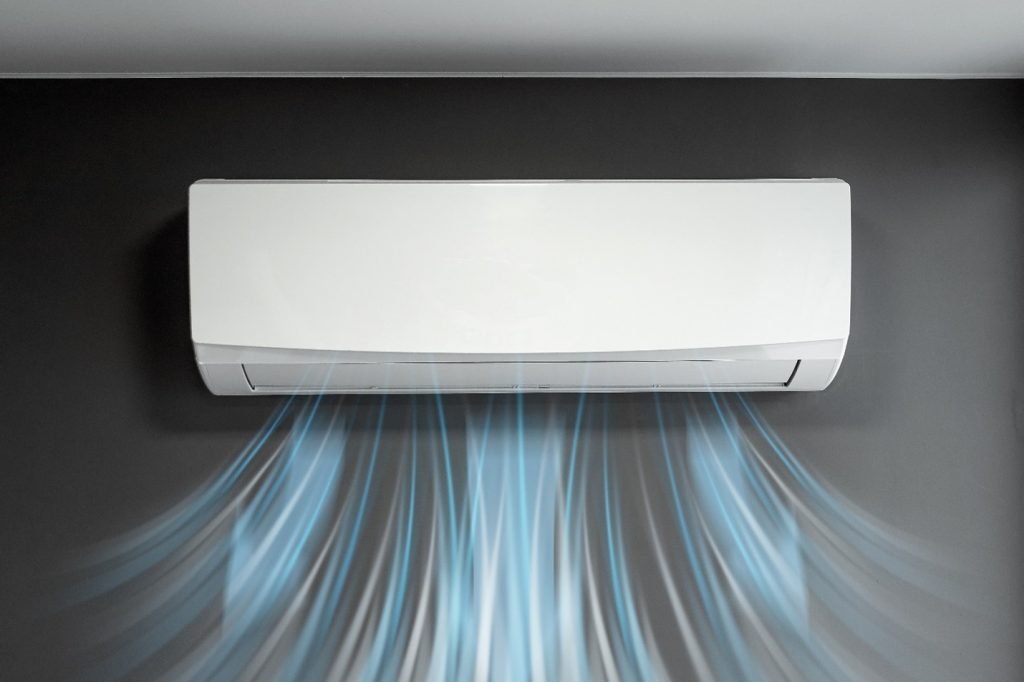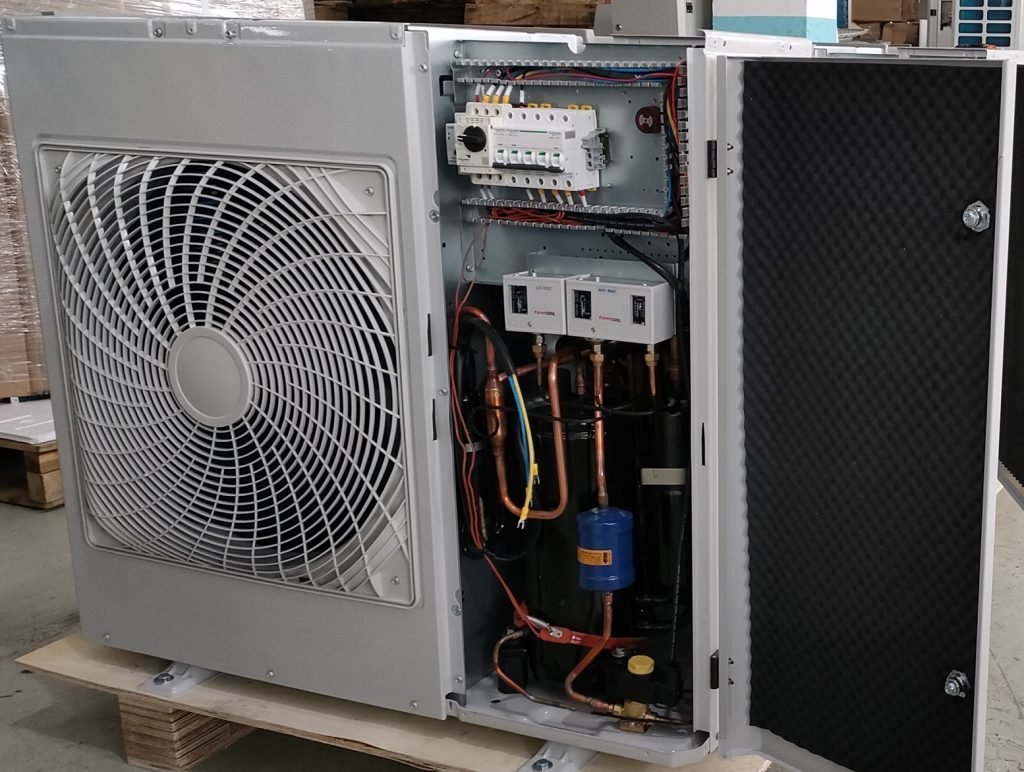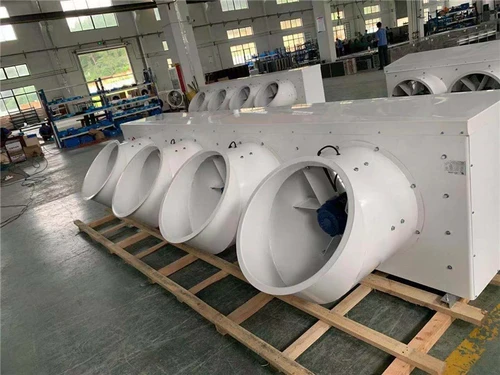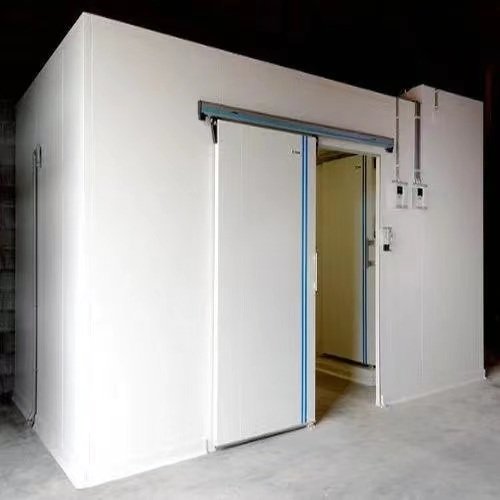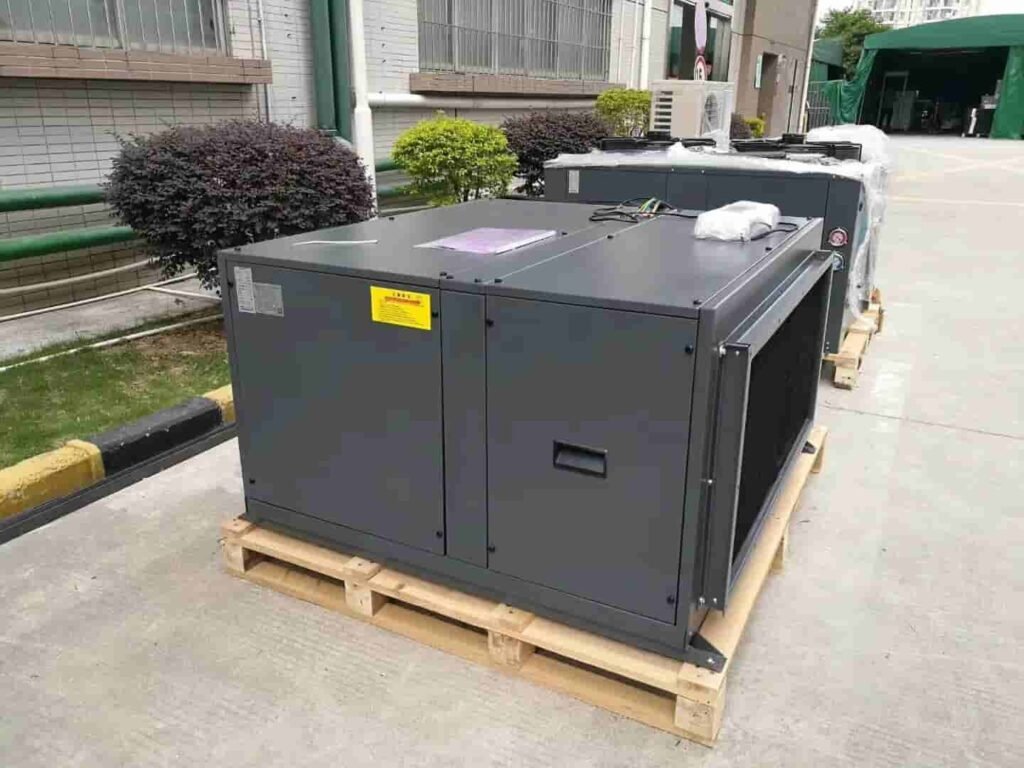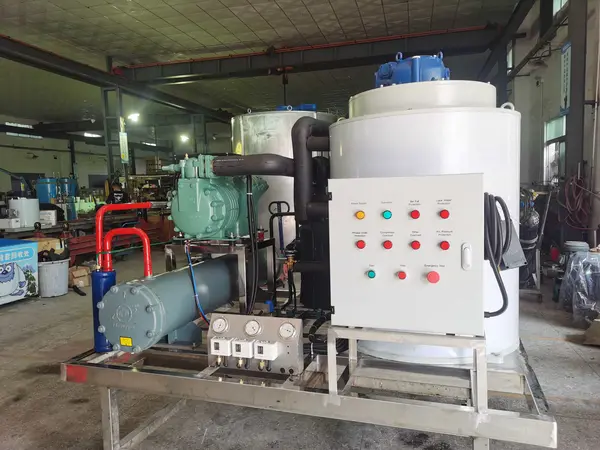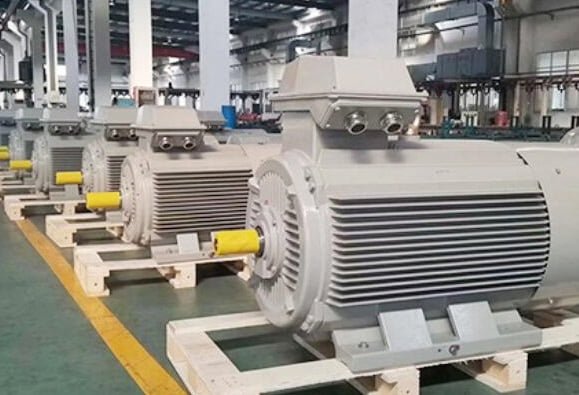Le navi da crociera moderne che navigano le vaste oceani sono come spostare "Cities da mare,"E uno dei componenti principali che supportano il funzionamento di questa enorme entità è il sistema a freddo nascosto sotto i mazzi.
Non è solo l'ancora di salvezza per preservare la fornitura alimentare quotidiana di migliaia di passeggeri, ma deve anche mantenere funzionalità precise tra scuotimento, corrosione salata, e condizioni meteorologiche estreme.
La nave da crociera stanza fredda Il sistema fonde perfettamente la scienza e l'ingegneria, resistere silenziosamente alle dure sfide del mare, renderlo invisibile “Rivoluzione a bassa temperatura” nella moderna tecnologia marittima.
Caratteristiche uniche della nave da crociera Cold Room
Stabilità dinamica
Nave da crociera Sistema della stanza fredda deve mantenere una temperatura costante in condizioni come il dondolo della nave (fino a 15 °), corrosione della nebbia salata (Concentrazione di sale ≥3%), e fluttuazioni di temperatura estrema (Una differenza di temperatura di oltre 60 ° C dalle regioni tropicali a quelle polari).
Autosufficienza a lungo termine
Per viaggi transoceanici, Il cibo deve essere conservato per più di 30 giorni. Per esempio, Le carni congelate devono essere mantenute a -22 ° C, e la frutta e le verdure refrigerate hanno bisogno a 0-4 ° C con 90% umidità, Posizionare elevate esigenze sulla stabilità delle attrezzature.
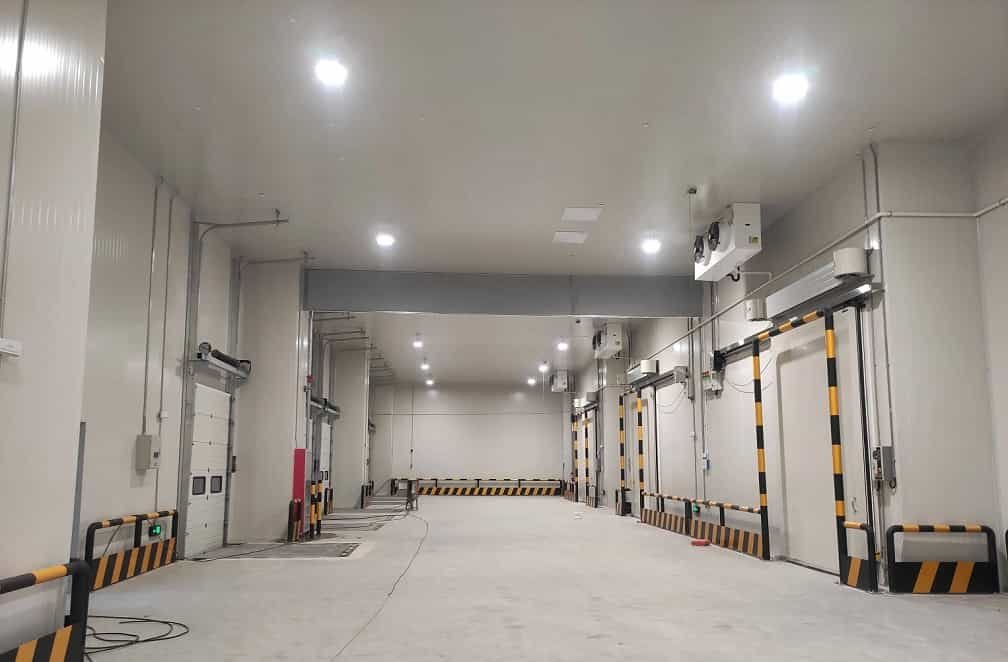
Dipendenza dai generatori della nave
Consumo di energia del stanza fredda Sistema Conti per 10%-15% dell'elettricità totale della nave. Compete per le risorse con il sistema di propulsione e le esigenze della cabina passeggeri. Se il generatore principale fallisce, L'energia di backup può supportare solo il sistema di stanza fredda 4-6 ore.
Priorità tecnologica a risparmio energetico
Usa compressori inverter (salva 50% energia) e sistemi di recupero del calore (Riutilizzare il calore dei rifiuti per il riscaldamento dell'acqua domestica), Ridurre il consumo giornaliero di carburante di 200-300 litri.
Previsione della previsione dell'inventario
Gli algoritmi di AI analizzano fattori come la nazionalità passeggeri e le rotte stagionali (per esempio., La domanda di frutti di mare è 30% Più in alto sulle rotte dell'Alaska), raggiungere un tasso di errore di approvvigionamento inferiore a 5%.
Capacità di conservazione degli alimenti di fascia alta
Linee di crociera di alto livello (per esempio., Crociere in mare d'argento) Avere una conservazione ultra-bassa a -30 ° C per preservare il tonno azzurro e le cantine di vino di umidità costante a 12 ° C per la conservazione dei vini bordeaux, che è diventato un punto di forza fondamentale per attirare clienti ad alto valore netto.
Sfide di progettazione e soluzioni adattive per la nave da crociera a freddo
1. Spazio e layout ottimali: Come massimizzare l'uso dello spazio limitato della cabina navale?
Sfida: Nave da crociera stanza fredda deve conservare cibo per migliaia di passeggeri in uno spazio compatto, Vicino a cucine e porte di alimentazione del ponte per abbreviare i percorsi di trasporto. La tradizionale sala fredda orizzontale occupa molto spazio, competere con altre funzioni navali (come cabine passeggeri e strutture di intrattenimento).
SOLUZIONE:
Design a strati verticali: Usa il sistema di scaffalature multistrato (in genere 3-4 strati, con altezze di 1.8-2.2 metri) per massimizzare lo spazio verticale nella cabina.
Unità di stanza fredda modulare: Moduli della stanza fredda prefabbricati (Dimensioni standard: 6M × 3M × 3M) può essere assemblato in modo flessibile per adattarsi a vari tipi di navi. Carnival Cruise's stanza fredda modulare Supporta cambi rapidi della zona di temperatura (per esempio., convertire un'unità di stanza fredda di 4 ° C in -18 ° C di conservazione congelata) per rispondere ai cambiamenti nelle richieste del percorso.
Pianificazione del flusso intelligente: Cold Room Collegamento alla cucina e alle porte di carico/scarico del ponte tramite le cinture del trasportatore elettrico (velocità: 0.5SM, carico: 500kg per viaggio), aumentare l'efficienza del trasporto di 300% e ridurre la frequenza delle aperture delle porte (Tagliare il consumo di energia da parte di 15%).
2. Corrosione e design sismico: Restringere l'ambiente marino duro
Sfida: Gli ambienti ad alta nebbia salata causano una rapida corrosione dei componenti metallici, Accordi la durata di vita di unità di stanza fredda. La nave sta dondolando (con un angolo di rollio fino a 15 ° e passo di 5 °) può causare spostamenti del carico e rotture di tubi.
SOLUZIONE:
UN) Materiali resistenti alla corrosione
Pannello cella frigorifera: 316L in acciaio inossidabile (con 2.5% molibdeno) offerte 3 volte migliore resistenza alla corrosione della nebbia salata rispetto a 304 acciaio inossidabile.
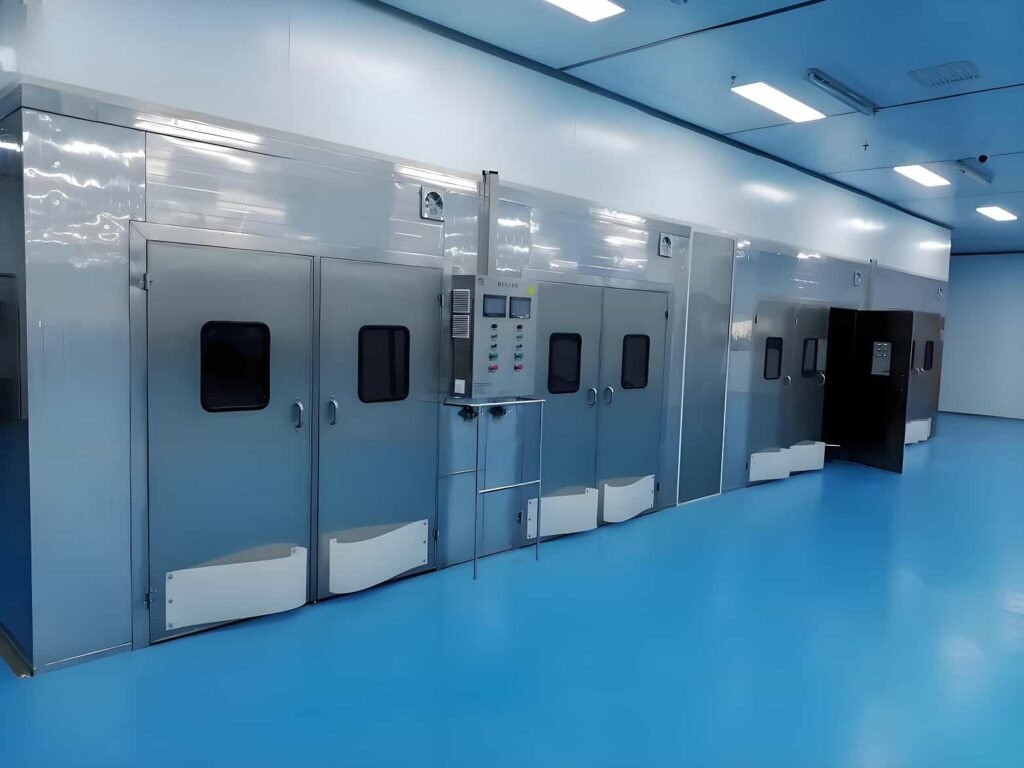
Scaffali interni: Acciaio zincato a caldo (con uno spessore dello strato di zinco ≥85μm), con la resistenza al test della nebbia salata che supera 1,000 ore.
Materiali di tenuta: Fluoroeelaste porta sigilli (intervallo di temperatura -40 ° C ~ 200 ° C), offerta 50% migliore resistenza all'invecchiamento rispetto alla normale gomma.
B) Tecnologia anti-vibrazione e anti-spostamento
Scaffali di bloccaggio a gravità: Gli scaffali hanno blocchi elettromagnetici (Blocca automaticamente quando l'alimentazione viene tagliata), in grado di resistere ad accelerazioni laterali di 0,3 g (equivalente alla forza inerziale della nave che oscilla a 15 °).
Collegamenti flessibili della pipeline: I tubi del refrigerante in rame utilizzano disegni di tubi ondulati (Espansione di ± 15 mm) con parentesi elastiche (coefficiente di smorzamento 0.7) Per ridurre il rischio di perdite dovute alle vibrazioni della nave.
Trattamento del pavimento anti-slip: Il pavimento della stanza fredda è rivestito con rivestimento anti-slip poliuretano (Coefficiente di attrito ≥0,6) e incorporato con scanalature in lega di alluminio (Spaziatura 1,2 m) per proteggere i pallet di carico.
3. Efficiente tecnologia di isolamento e tenuta: Combattere la perdita di aria fredda e un aumento del consumo di energia
Sfida: La differenza di temperatura tra all'interno e all'esterno del stanza fredda L'unità su una nave da crociera può raggiungere 50 ° C (per esempio., Temperatura esterna di 35 ° C in mare tropicale, con temperatura interna a -15 ° C), Rendere insufficienti materiali isolanti tradizionali per le esigenze di risparmio energetico. Le frequenti operazioni delle porte portano a perdita di aria fredda, aumentando ulteriormente il consumo di energia.
SOLUZIONE:
Pannelli di isolamento a vuoto (VIP): Composto da materiale del nucleo in fibra di vetro e film di barriera in alluminio, con uno spessore di soli 50 mm e conduttività termica ≤0,005 W/(m • k), offerta 4 volte l'efficienza dell'isolamento della tradizionale schiuma poliuretanica: 0.02Con(m • k).
UN) Sistemi di porte a tenuta aerea
Porte di aereo in rapida chiusura: Pneumaticamente guidato (tempo di chiusura: 0.5 secondi), con strisce riscaldate attorno agli spazi vuoti della porta (Mantenere 40 ° C.) per prevenire la glassa. La perdita di aria fredda per apertura della porta è ridotta 70%.
Camere di transizione a due porte: Una camera di transizione (1.5M profondo) al stanza fredda Entrata, con due porte che si aprono alternativamente per bloccare il flusso d'aria diretto tra l'interno e l'esterno.
Monitoraggio del sigillo intelligente: Sensori di pressione (Precisione ± 0,1Pa) Sulle spazi della porta rilevano lo stato di sigillatura in tempo reale. Se viene rilevata una pressione anormale (per esempio., guasto del sigillo), attiverà un allarme, e attiva il fermo della porta magnetica di backup (con una forza di mantenimento ≥500n).
4. Adattamento ad ambienti estremi: Capacità di refrigerazione dalle regioni tropicali a quelle polari
Sfida: I mari tropicali presentano alte temperature e umidità (per esempio., Temperatura del ponte estivo caraibico di 45 ° C, 90% umidità), causando il impianto di refrigerazione per celle frigorifere Per sperimentare carichi pesanti.
In percorsi polari, Basse temperature (-30°C) causare il ghiaccio lo strato esterno della stanza fredda, influire sulle prestazioni dell'isolamento.
SOLUZIONE:
UN) Refrigerazione migliorata per ambienti tropicali
Sistema di refrigerazione a compressione a due stadi: Un compressore ad alta temperatura (POLIZIOTTO 4.2) Pre-cools l'aria, e un compressore a bassa temperatura (POLIZIOTTO 2.8) riduce ulteriormente la temperatura, Migliorare l'efficienza complessiva del sistema di 30%.
Condensatore raffreddato in acqua di mare: Utilizza l'acqua di mare (Temperatura ≤32 ° C.) da sotto la nave per raffreddare il refrigerante, offerta 40% più efficienza energetica rispetto ai condensatori raffreddati ad aria.
B) Misure anti-occidentali per le regioni polari
Film di riscaldamento elettrico: Film di riscaldamento in fibra di carbonio (energia: 200W/m²) incorporato nel muro esterno del stanza fredda mantenere una temperatura superiore a 0 ° C, impedire al congelamento della condensa.
Ulteriore livello di isolamento: Aggiungi una coperta di aerogel di spessore 50 mm, conducibilità termica 0,018 W/(m • k), allo strato esterno della stanza fredda su rotte polari, migliorare la resistenza termica complessiva di 25%.
Cruise Ship Cold Room Room e layout di cablaggio
IO. Progettazione del sistema della pipeline
1. Layout della pipeline del refrigerante
UN) Selezione del materiale
Pipeline del refrigerante principale: Tubi di rame senza soluzione di continuità (Standard ASTM B280), Spessore della parete ≥1,5 mm, Resistenza alla pressione ≥4,2 milioni, Adatto ai refrigeranti come l'ammoniaca (Nh₃) e CO₂.
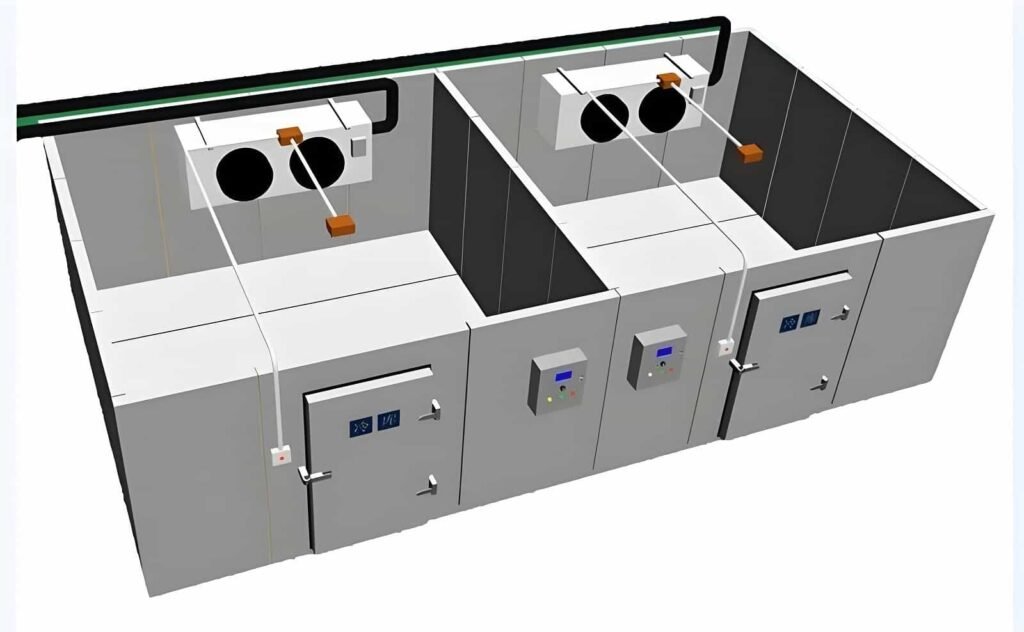
Protezione della corrosione: Il muro esterno è rivestito con un PVC (Polivinil cloruro) strato resistente alla corrosione (spessore: 2mm), e il muro interno è nichelato (spessore: 50μm), Migliorare la resistenza alla corrosione della nebbia salata ed estendere la durata della vita a 20 anni.
B) Principio di layout
Routing a strati: Il tubo di alimentazione del liquido principale (diametro 50-80mm) si trova nella parte superiore del stanza fredda, mentre il tubo del gas di ritorno (Diametro 80-120mm) si trova in fondo. La distanza tra i tubi del ramo verticale è ≤2m, ridurre la caduta di pressione (ΔP < 5%).
C) Design sismico
Compensatori a tubi ondulati: Installa tubi ondulati in acciaio inossidabile (Capacità di espansione ± 15 mm) ogni 6 Contatori per assorbire lo spostamento dei tubi causato dalla nave oscillazione.
Ganci elastici: Ganci di smorzamento in gomma (coefficiente di smorzamento 0.7) consentire il movimento laterale di tubi fino a ± 10 cm.
D) Trattamento dell'isolamento
Materiale isolante: Schiuma elastomerica a cellule chiuse (Conducibilità termica 0,033W/(m • k)), con spessore progettato in base al gradiente di temperatura (per esempio., 60Isolamento mm per tubi -30 ° C).
Strato protettivo esterno: Vetroresina composito in alluminio (resistenza alla trazione ≥50 MPA) per prevenire danni meccanici e degrado UV.
2. Tubi di condensa e drenaggio
Design del pendio: La pendenza del tubo di drenaggio è ≥3% per garantire che la condensa fluisca naturalmente sulla camera di raccolta inferiore della nave (capacità: 500-1000l), prevenire l'accumulo di acqua e la crescita batterica.
UN) Misure antigelo
Nastro riscaldante: Avvolgi un nastro riscaldante autoregolante (15W/m Potenza) intorno all'esterno del tubo di drenaggio per mantenere la temperatura della tubazione >5°C, prevenire i blocchi causati dal congelamento in ambienti polari.
Requisiti materiali: Tubi UPVC (Resistente alla corrosione e resistente alla temperatura fino a -40 ° C) con giunti adesivi a base di solventi per prevenire perdite.
Ii. Progettazione del sistema di cablaggio elettrico
1. Layout del cablaggio dell'alimentazione
UN) Selezione dei cavi
Linea elettrica principale: Senza alogeno, fiorire, Cavi di fiamma retardante (CEI 60092 standard), con area trasversale scelta a 1.25 volte la corrente di carico (per esempio., Per un carico 100A, Utilizzare il cavo da 25 mm²).
Cavi ambientali a bassa temperatura: Cavi isolati in gomma in silicone (intervallo di temperatura: -60° C a 180 ° C.), utilizzato per il collegamento interno Attrezzatura per camera fredda.
B) Percorso di routing
Vassoi via cavo: Installare i vassoi dei cavi in acciaio zincato (larghezza 200 mm, Altezza 100 mm) in cima al stanza fredda, con cavi di alimentazione (strato superiore) e cavi di controllo (strato inferiore) posato in strati separati, con una spaziatura di ≥300 mm per evitare l'interferenza elettromagnetica.
Protezione della penetrazione del ponte: I cavi che passano attraverso i mazzi sono protetti con ghiandole sigillanti impermeabili (Valutazione IP68) per prevenire l'infiltrazione dell'acqua di mare.
C) Design di ridondanza
Circuiti a doppia potenza: Attrezzatura centrale (per esempio., compressori, sistemi di controllo della temperatura) è alimentato da due circuiti indipendenti, Con un tempo di commutazione <0.1 secondi.
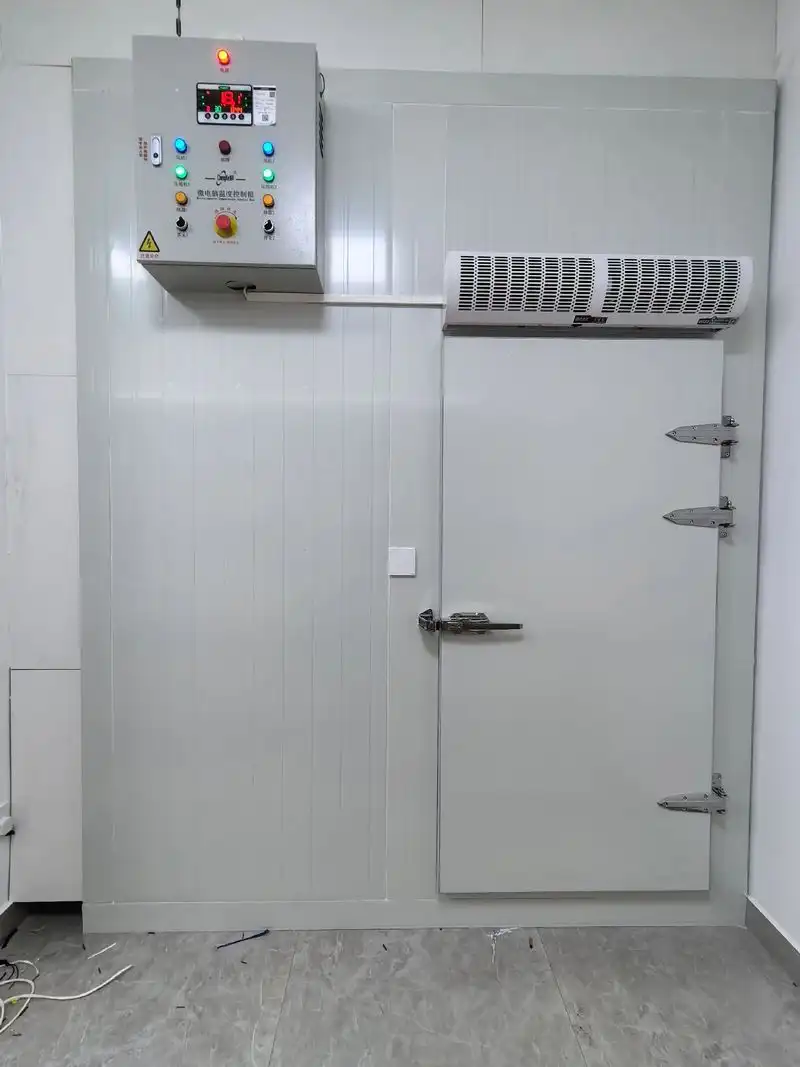
2. Cablaggio di controllo e segnale
UN) Misure anti-interferenza
Cavi a coppia attorcigliata schermate: I cavi del segnale sensore usano STP (Coppia attorcigliata schermata) Cavi (Copertura di schermatura ≥90%), con resistenza a terra ≤1Ω, per sopprimere il rumore elettromagnetico.
Comunicazione in fibra ottica: Utilizzare cavi in fibra ottica a più modalità (Attenuazione ≤3db/km) per trasmissione a lunga distanza (per esempio., tra i mazzi), Evita le gocce di tensione e l'interferenza.
B) Sigillatura a prova di umidità
Scatole di giunzione: Scatole di giunzione all'interno del stanza fredda sono realizzati in acciaio inossidabile (316l), riempito con sigillante resina epossidica (Valutazione impermeabile IP69K).
Iii. Tecnologia di risposta ambientale speciale
1. Resistenza alla corrosione della nebbia salata
Protezione della pipeline e del cavo: La superficie esterna è rivestita con un rivestimento di zinco-alluminio (spessore 80μm) e pistolo in poliuretano (Spessore 50μm), con la resistenza alla nebbia salata ≥2.000 ore.
I giunti via cavo sono sigillati con tappi di gomma siliconica (Valutazione della resistenza alla nebbia salata ASTM B117).
2. Resistenza sismica e di vibrazione
Fissaggio della pipeline: Installa supporti antisismici tutti 1.5 metri (Carico ≥500 kg), con i supporti saldati alla struttura della nave (resistenza alla saldatura ≥90% del materiale di base).
Anti-loosing cavo: Installa le cravatte con zip in nylon (resistenza alla trazione ≥50 kg) Nei vassoi per cavi (Spaziatura ≤0,5 m) Per evitare che i cavi si spostano a causa del movimento della nave.
3. Compensazione dell'espansione termica
Compensatori a tubo: Installa giunti di espansione di tipo Omega (Capacità di compensazione ± 10 mm) Ogni 20 m lungo le sezioni del tubo diritta per assorbire lo stress termico causato da variazioni di temperatura.
Indennità di espansione del cavo: Riserva a “S” Cending a forma (lunghezza ≥1m) Alle estremità del cavo, consentendo una variazione di lunghezza ± 5%.
IV. Rilevamento e manutenzione
1. Monitor di perdita
UN) Sensori di perdita del refrigerante
Sistema di refrigerazione dell'ammoniaca: Installare sensori elettrochimici (limite di rilevamento ≤5ppm), con un sensore per 50m².
Sistema di refrigerazione di co₂: Sensori di assorbimento a infrarossi (Limite di rilevamento ≤1000ppm) Fornire trasmissione di dati in tempo reale al centro di controllo.
2. Test di isolamento
Vengono condotti controlli regolari di resistenza all'isolamento dei cavi utilizzando un MegohMmeter (2,500In DC), con una resistenza minima di ≥100mΩ. Se viene rilevato l'invecchiamento, Sostituire immediatamente il cavo.
3. Ispezione automatizzata
Usa il robot di ispezione basato su ferrovie (per esempio., SMP Robotics S5) Con un imager termico e i rilevatori di gas eseguono una scansione completa della pipeline una volta al mese, generare una mappa di difetto 3D.
Misure di sicurezza e di emergenza
La gestione della sicurezza della nave da crociera stanza fredda deve assicurarsi “zero incidenti” Sotto le sfide degli spazi confinati, ambienti a bassa temperatura, e i rischi unici dell'ambiente marittimo (come il dondolo della nave e la corrosione della nebbia salata).
Le misure di emergenza dovrebbero coprire più scenari, compresi i guasti delle apparecchiature, Sicurezza del personale, fuoco, e perdite.
Di seguito sono riportati i guasti dettagliati dei requisiti tecnici chiave e degli standard operativi.
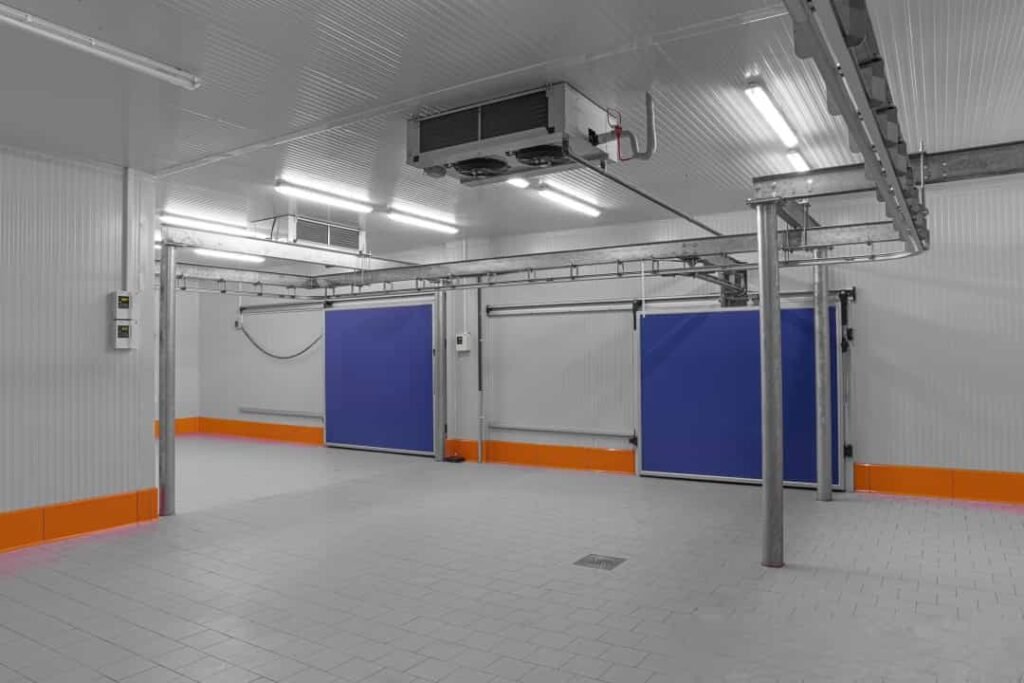
IO. Misure di prevenzione degli incendi e protezione da esplosione
1. Standard di progettazione della protezione antincendio
Infiammabilità materiale: L'isolamento della parete della stanza fredda utilizza il poliuretano di fiamma (indice di ossigeno ≥28%), con lo strato di protezione esterno realizzato in piastre in acciaio zincato (Punto di fusione 419 ° C.), Incontrare gli standard di protezione antincendio IMO A-60 (Temperatura posteriore ≤180 ° C all'interno 60 minuti).
I cavi sono privi di alogeni e a bassa figura (CEI 60332-3-22 standard), con densità di fumo ≤50% e il rilascio di gas tossici (per esempio., HCl) ≤5%.
UN) Sistema di estinzione antincendio attivo
Sistema di soppressione del fuoco CO₂: Ugelli di co₂ incorporati all'interno del stanza fredda (densità di copertura ≥1 kg/m³), rilasciando CO₂ all'interno 30 secondi, ridurre la concentrazione di ossigeno al di sotto 15%.
Sistema di soppressione del fuoco della nebbia d'acqua: Per incendi elettrici, Usa nebbia d'acqua fine ad alta pressione (Dimensione delle particelle ≤200μm), con una velocità di spruzzo di 2L/min • m² per evitare danni alle attrezzature causati dai sistemi di irrigazione tradizionali.
2. Design di protezione dell'esplosione
Protezione dell'esplosione del sistema di refrigerazione dell'ammoniaca: Installare i sensori di perdita di gas ammoniaca (limite di rilevamento ≤10pm) All'interno della stanza fredda, collegato ai ventilatori a prova di esplosione (flusso d'aria ≥2000m³/h).
Le apparecchiature elettriche sono classificate ex d iib t4 (Temperatura superficiale ≤135 ° C.), prevenire i rischi di accensione da scintille elettriche.
Controllo del refrigerante infiammabile: Per R290 (propano) refrigeranti, La stanza fredda utilizza un sistema di monitoraggio della concentrazione, con il limite inferiore dell'esplosione (Lel) impostato su 20% per scopi di allarme (R290 lel = 2.1%).
Ii. Risposta di emergenza delle perdite del refrigerante
1. Rilevamento e localizzazione delle perdite
Rete di sensori: Installare i sensori Co₂ di assorbimento a infrarossi (Limite di rilevamento ≤500pm) o sensori NH₃ elettrochimici (limite di rilevamento ≤5ppm) ogni 50m².
Aggiorna i dati in tempo reale sono nella sala di controllo centrale, e le mappe termiche 3D visualizzano la sorgente di perdita.
Livelli di allarme udibile e visivo:
| Concentrazione di perdite | Misure di risposta |
|---|---|
| Livello 1 (≤lel 20%) | Avvia la ventilazione locale, Il personale indossa i respiratori per l'ispezione. |
| Livello 2 (Lel 20%-50%) | Chiudere l'area di perdita, Avvia la trasmissione di evacuazione a livello di nave. |
| Livello 3 (≥lel 50%) | Rilasciare il sistema di soppressione del fuoco inondazione completa, Tagliare l'alimentazione principale. |
2. Evacuazione e salvataggio del personale
Percorsi di fuga di emergenza: Stanza fredda ha porte di fuga bidirezionali (larghezza ≥0,8 m), con un sistema di controllo degli accessi che si sblocca automaticamente quando l'alimentazione viene tagliata.
Strisce guida fluorescenti (luminosità ≥100cd/m²) sono posti sul pavimento per guidare il personale durante l'evacuazione.
Attrezzatura per la protezione della respirazione: Conservare i respiratori dell'aria a pressione positiva (Tempo di utilizzo ≥30 minuti) in armadi a prova di esplosione entro ≤5m dalla porta.
Iii. Interruzioni di corrente e risposta di guasto dell'attrezzatura
1. Backup di potenza a più livelli
Design di ridondanza di energia:
| Tipo di fonte di alimentazione | Tempo di cambio | Capacità di potenza | Copertura |
|---|---|---|---|
| Generatore principale | Nessun tempo di commutazione | 100% carico | Intera nave |
| Batteria al litio navale | ≤10 secondi | Pieno carico per 4 ore | Core Cold Room |
| Generatore di diesel di emergenza | ≤60 secondi | Core Cold Rom (deposito medicinale) per 12 ore | Zone di temperatura critiche |
2. Riparazione rapida dell'attrezzatura
Design di sostituzione modulare: I componenti chiave come compressori ed evaporatori utilizzano interfacce rapide (per esempio., DA 2848 Flange), con tempo di sostituzione ≤2 ore.
Conservare i refrigeranti di riserva (per esempio., Serbatoi di CO₂ con capacità ≥200 kg) a bordo per supportare la ricarica rapida.
Supporto tecnico remoto: Utilizzare la comunicazione satellitare per connettersi con gli esperti onshore per l'analisi in tempo reale degli spettri di vibrazione delle apparecchiature e dei dati operativi, Guidando i membri dell'equipaggio nella risoluzione dei problemi.
IV. Standard di sicurezza del personale
1. Misure di protezione del lavoro a freddo
Attrezzatura di protezione personale (DPI): Abiti da tempo freddo riscaldato elettrico (Mantenere la temperatura superficiale di 30 ° C), Valutazione per temperature fino a -50 ° C.
Stivali di sicurezza anti-slip (Coefficiente di attrito ≥0,5), con dita di punta in acciaio e suole anti-porticelle.
Limiti di tempo di lavoro: Tempo di lavoro continuo per persona ≤20 minuti; tempo totale nel stanza fredda per turno ≤60 minuti.
2. Procedure operative sicure
Regola operativa a due persone: Due persone devono entrare insieme nella stanza fredda, Indossare rilevatori di ossigeno portatili (intervallo di rilevamento: 0-25% O₂).
Controllo di accesso: Porte della stanza fredda Deve avere un dispositivo di sblocco di emergenza interno (manico meccanico), che può ancora essere aperto manualmente anche se si perde il potere.
v. Esercitazioni di emergenza e formazione
1. Sistema di perforazione simulato
Copertura dello scenario: Fuoco (Simulando il rilascio di fumo e le operazioni antincendio), Perdita del refrigerante (Formazione della realtà virtuale), personale intrappolato (Salvataggio dell'ambiente a bassa temperatura).
Frequenza di perforazione: Esercitazioni dell'equipaggio completo ogni trimestre (4 volte all'anno), con una formazione speciale per le posizioni chiave (per esempio., Manager della stanza fredda) su base mensile.

2. Certificazione di qualificazione dell'equipaggio
Contenuto di formazione obbligatorio: Linee guida internazionali IMO per il funzionamento sicuro di Stanza fredda sulle navi (MSC.1 / Circ.1582) esame teorico.
Valutazione pratica: Indossare un respiratore a pressione positiva (≤60 secondi), Attivazione del sistema di soppressione del fuoco Co₂ (≤30 secondi).
Conclusione
Nave da crociera stanza fredda è un microcosmo della moderna tecnologia marittima, Con il suo design e il suo funzionamento che incarnano i risultati di Pinnacle in ingegneria, Scienza dei materiali, e tecnologie intelligenti. Nell'ambiente estremo dell'oceano, La stanza fredda non solo funge da “Lancia di salvezza” Garantire la sicurezza del cibo per migliaia di persone, ma rappresenta anche il nucleo delle capacità di competitività del marchio di una nave da crociera e di sviluppo sostenibile.
Dai materiali resistenti alla corrosione alla tecnologia di isolamento a vuoto, Dai sistemi di controllo della temperatura dinamici alle catene di alimentazione guidate dall'IA, nave da crociera stanza fredda ha risolto le triple sfide dei limiti di spazio, colli di bottiglia di energia, e vincoli ambientali attraverso un design preciso. Il suo valore fondamentale risiede non solo a temperature a partire da -30 ° C o fino a 50 ° C, ma anche nel trasformare le variabili marine incontrollabili in calcolabili, prevedibile, e parametri di ingegneria ottimizzabile.
In futuro, come refrigeranti verdi (come idrogeno e aria liquida), Operazioni autonome e manutenzione (ispezioni robot, gemelli digitali), e energia zero-carbonio (Recupero di energia fredda di GNL, celle a combustibile marino) diventare più diffuso, nave da crociera stanza fredda si evolverà da a “Unità funzionale” in un “nodo ecologico intelligente.” Nell'era della navigazione neutrale a carbonio, Non solo fungerà da hub di conservazione degli alimenti, ma anche come terreno di test per l'innovazione tecnologica e un barometro per la trasformazione del settore.
Eventuali commenti?
Benvenuto, lascia un messaggio o ripubblicalo.



